Risk Factors of Depression Screened by Two-Sample Mendelian Randomization Analysis: A Systematic Review*
WANG Han Lin, XUE Yan Feng, CUI Bao Qiu, LIU Hong,#, and SHEN Xin Xin
1. Shandong Provincial Research Center for Bioinformatic Engineering and Technique, School of Life Sciences,Shandong University of Technology, Zibo 255049, Shandong, China; 2. Shanxi Province Cancer Hospital/Shanxi Hospital Affiliated to Cancer Hospital, Chinese Academy of Medical Sciences/Cancer Hospital Affiliated to Shanxi Medical University, Taiyuan 030013, Shanxi, China; 3. State Key Laboratory of Infectious Disease Prevention and Control, National Institute for Viral Disease Control and Prevention, Chinese Center for Disease Control and Prevention, Beijing 102206, China
Abstract
Key words: Risk factors; Drug targets; Depression; Major depressive disorder; Two-sample Mendelian randomization
INTRODUCTION
The prevalence of depression, one of the most common psychiatric disorders, has lack of self-control, and sleep disorders[1,2].Some severe cases manifest as self-mutilation and suicide[3,4].Depression affects subjects of all ages and social strata and is the leading cause of human disability and death worldwide.In addition, it causes enormous economic losses and social burdens[5,6].
The pathogenesis of depression is complex,and no effective treatment has been discovered.Several recent studies have been conducted to identify the risk factors, a crucial step toward decreasing the incidence of depression.Depression is often associated with sleep disturbances, such as insomnia or hypersomnia[7],yet chronic sleep disturbances cause metabolic abnormalities and increase the risk of obesity and diabetes.Depression is more common in diabetic individuals and may be a risk factor for developing type 2 diabetes[8,9].However, the associations between risk factors and depression have not been fully explored since observational studies lack clear demarcations between causality and false correlation due to confusion and reverse causality.Therefore, this study used the twosample Mendelian randomization (2SMR) method to identify depression factors and major depressive disorders (MDD) from metabolites,diseases, and risk factors.The 2SMR has several advantages over traditional observational studies,which are limited by confounders.
Moreover, 2SMR is widely used to estimate the causal relationships between risk factors and various diseases[10].Further analysis was conducted for the significant MDD-associated diseases to explore the relationship between their drug targets and MDD[11].A schematic representation of the study design is shown in Figure 1.
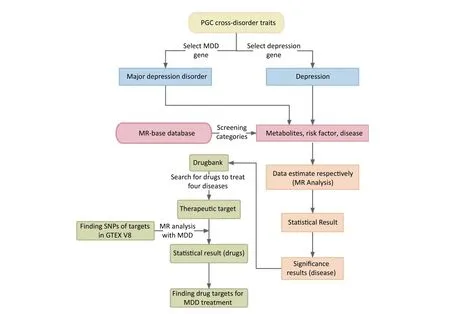
Figure 1.Summarization of analytic design to screen risk factors for depression and MDD.The overall data statistics were performed in three processes: a) finding relevant representative depression modifiable factors and environmental risk factors through MR-base database; b) compiling the data computationally and visualizing the results through two-sample MR calculation method; c) finding depression-related protein targets in DrugBank online database, and the SNP corresponding to each drug target was obtained in GTEX V8 with the found depression-related factors for calculation to identify relevant important drug targets.MDD, major depressive disorder; MR, Mendelian randomization;SNP, single nucleotide polymorphism; PGC, psychiatric genomics consortium.
METHODS
Data Source
The MR-Base platform is a repository for approximately 11 billion single nucleotide polymorphisms (SNPs) and the associated traits.The tool is used for systematic analysis of the causal relationship between risk factors and human phenotypes.Briefly, the database comprises i) data on 144 sets of disease factors classified into 9 subcategories and results on 55 different diseases; ii)data on 292 metabolic factors grouped into 13 subcategories and results on 256 different metabolites; and iii) data on 134 sets of risk factors classified into 19 subcategories and results on 62 different risk factors[12].
Exposure factor category columns for metabolites, diseases, and risk factors selected from MR-Base included several outcome factors.The outcome factors for depression included 7,624,934 SNPs in 113,769 patients with extensive depression and possible MDD and data on 208,811 healthy controls of European ancestry in 2018[13].The other dataset was selected for major depression in 59,851 patients and 113,154 health controls of European ancestry, including data for 13,554,550 SNPs in 2018[14].The genetic variations of depression and MDD come from the psychiatric genomics consortium (PGC)[15].A systematic search was performed in the MR-Base database for all factors up to May 2022.
Standardized Data Processing
The genome-wide significance (P< 5 × 10-8) and independent inheritance (r2< 0.001) associated with depression and MDD [without any linkage disequilibrium (LD)] were evaluated from the MRbase database.A search for proxy SNPs was conducted at R2= 0.8 minimum LD and if it has no SNPs for a particular request from GWAS, summary statistics for the outcome.Four 2SMR methods,including inverse variance weighted (IVW),Mendelian randomization (MR-Egger), weighted median, and weighted mode, were used for the data analysis[16].In addition, heterogeneity, multiple validity, and leave-one-out sensitivity analysis tests were performed.In the heterogeneity test,whenever risk factors were < 0.05 Q_pval, a random effects model was used to estimate the MR effect size and determine whether the risk factors were causally related to depression.In the pleiotropy test,horizontal pleiotropy between multiple valid instrumental variables (IVs) was tested using the MREgger intercept term to indicate if the intercept term is significantly different from zero (0 indicates the presence of horizontal pleiotropy).Finally, leaveone-out sensitivity analysis was used to test for the presence of SNPs that have a disproportionate effect on MR estimation.The IVW value was the main analytic parameter for all the analyses conducted using the 2SMR package in R (version 4.2.1; the R Foundation for Statistical Computing)[12].
Identifying the MDD Drug Targets
The protein targets of the drugs for the significant diseases associated with MDD were selected for subsequent analyses.The genetic variants associated with the exposure measures were used as indicators to assess the causal effect based on the outcome factors selected from the MRBase platform.We searched the DrugBank database with the term retrieve drugs and target genes for depression[11]to select the exposure factors.The search details included the drug name, DrugBank ID,target gene, target type, and the corresponding SNPs selected from the GTEx V8 catalog[17].Data analysis was conducted using the 2SMR package in R software.The fixed-effect inverse variance weighted(FE-IVW) was selected as the main analysis method because it is the most reliable with IVs[15].
Additionally, the weighted median, weighted mode, and MR-Egger methods were used to improve the reliability of the causal inference.AP-value <0.05 was selected as the discriminant criterion for statistical significance.Heterogeneity and pleiotropy tests were selected in the 2SMR package for subsequent analyses.Cochran’s Q statistics were calculated to explore the data heterogeneity, and the intercepted term of the MR-Egger was used to determine the presence of pleiotropy.
RESULTS
Associations between Risk Factors, Depression, and MDD
Data from 1,001 factors retrieved from the MRbase database were analyzed.The metabolites,disease, and risk factors were selected and collated to form 38 subcategories.The results contained 459 factors, 17,826 SNPs, and 15 subcategories of depression.The subcategories that were significantly(P-value < 0.05) associated with depression included amino acid, anthropometric, autoimmune/inflammatory, behavioral, diabetes, education, fatty acid, glycemic, lipid, nucleotide, peptide, personality,protein, psychiatric/ neurological, and sleeping(Supplementary Table S1, available in www.besjournal.com).Additionally, the results contained 424 factors, 18,211 SNPs, and 7 MDD subcategories.The subcategories that were significantly (P-value <0.05) associated with MDD included anthropometric,behavioral, education, glycemic, personality,psychiatric/neurological, and sleeping(Supplementary Table S2, available in www.besjournal.com).
Visualization of the Results with Depression and MDD
The IVW calculations for exposure factors,depression, and MDD were visualized in the MRBase database.The x-axis represented the log change or the change caused by a decrease in each SD for the 459 and 424 selected traits, respectively.In contrast, the y-axis represented the reference evidence indicating a causal relationship between a single environmental factor and depression with-log10(Pval) > 1.3 (P-value < 0.05).The three colors in the figure represent disease, metabolites, and risk factors, respectively.The overall distribution was symmetrical, but the levels of the three environmental factors were significantly different.Metabolic factors were predominant, followed by risk factors and diseases (Figure 2A).Psychiatric/neurological and autoimmune/inflammatory diseases were significantly associated with depression (Figure 2B).Moreover, amino acids, fatty acids, and peptides were the representative metabolites associated with the risk of depression(Figure 2C).Among the risk factors, education,behaviors, and anthropometrics were significantly associated with depression (Figure 2D).The overall distribution was symmetrical, showing that the risk factors were positively distributed (Figure 3A).Psychiatric/neurological and autoimmune/inflammatory diseases were significantly associated with the subcategories of depression (Figure 3B).Fatty acid, metabolite ratio, and lipid are significantly correlated with the risk of depression (Figure 3C).The risk factors significantly correlated with depression were education, anthropometrics, and lipid (Figure 3D).
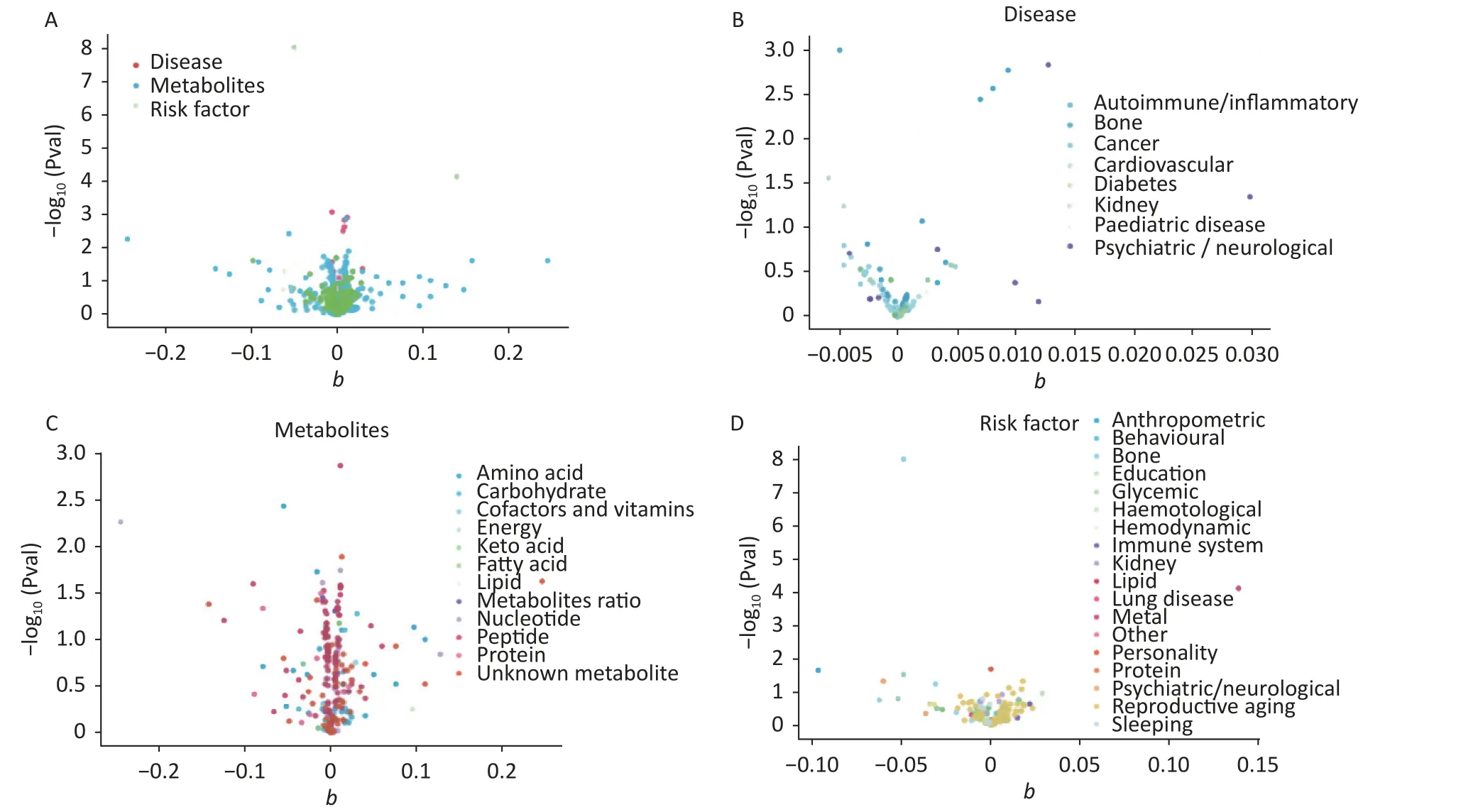
Figure 2.The x-axis shows the change of log OR caused by the decrease of each SD in 459 traits, and the y-axis displays the relevant P-value.Setting -log10 (Pval) > 1.3 (i.e.P-value < 0.05).(A) Effect of 459 traits on depression; (B) Effect of disease on depression; (C) Effect of metabolites on depression; (D) Effect of risk factor traits on depression.OR, odds ratio; SD, standard deviation
Data Statistics
The 1,001 environmental risk factors collected from the MR-Base database included 459 for depression and 43 factors withP< 0.05(Supplementary Table S3, available in www.besjournal.com) (Figure 4).Laurate (IVW,OR= 0.78,95%CI:0.66–0.93,P= 0.01), alcohol consumption(IVW,OR= 0.91, 95%CI: 0.84–0.99,P= 0.02), 3-dehydrocarnitine (IVW,OR= 0.91, 95%CI: 0.84–0.99,P= 0.02), and chronotype (IVW,OR= 0.94, 95%CI:0.98–1.00,P= 0.05) were significantly associated with decreased risk of depression.However, uridine(IVW,OR= 1.17, 95%CI: 1.02–1.34,P= 0.02) and neuroticism (IVW,OR= 1.15, 95%CI: 1.07–1.23,P<0.01) (Table 1) were significantly associated with increased risk depression.
Furthermore, the 1,001 environmental risk factors collected from the MR-Base database included 424 results for MDD, and MDD was considered an outcome factor (Supplementary Table S4, available in www.besjournal.com).Thirty environmental risk factors were associated with MDD (Figure 5).Laurate (IVW,OR= 0.21, 95%CI:0.07-0.66,P< 0.01), years of education (IVW,OR=0.72, 95%CI: 0.64-0.81,P< 0.01), and the ratio of bisallylic groups to double bonds (IVW,OR= 0.94,95%CI: 0.90-0.98,P< 0.01) were significantly associated with the decreased risk of MDD.The risk factors significantly correlated with increased risk factors included PGC cross-disorder traits (IVW,OR= 1.32, 95%CI: 1.15-1.51,P< 0.01), attention deficit hyperactivity disorder (ADHD) (IVW,OR=1.20, 95%CI: 1.12-1.29,P< 0.01), and obesity class 1 (IVW,OR= 1.13, 95%CI: 1.05-1.21,P< 0.01)(Table 2).
We performed heterogeneity tests, multiple validity tests, and leave-one-out sensitivity analyses for each significant outcome.The heterogeneity analysis generated 16 results with < 0.05 Q_pval.Thus, we used a random effects model to estimate the MR effect size, which confirmed that the outcomes were causally related to depression (Pval <0.05).Besides, the multiplicity test showed that each significant outcome (Pval > 0.05) lacked horizontal multiplicity.The leave-one-out sensitivity analyses of each significant outcome showed that no specific SNPs influenced the results (Supplementary Table S5 and Supplementary Figures, available in www.besjournal.com).
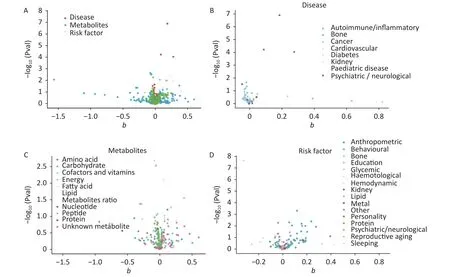
Figure 3.The x-axis shows the change of log OR caused by the decrease of each SD in 424 traits, and the y-axis displays the relevant P-value.Setting -log10 (Pval) > 1.3 (i.e.P-value < 0.05).(A) Effect of 459 traits on MDD; (B) Effect of disease on MDD; (C) Effect of metabolites on MDD; (D) Effect of risk factor traits on MDD.MDD, major depressive disorder; OR, odds ratio; SD, standard deviation.
In-silico Results Correspond with Disease Tests
The conditions with significant risk factors,including primary sclerosing cholangitis (PSC), were confirmed through tests.The purpose was to prove the reliability of the results.Patients with chronic diseases have a higher rate of depression than the normal population[18], but PSC (IVW,OR= 1.00, 95%CI: 0.99-1.00,P< 0.01) does not increase the risk of depression.Research trials showed that depression is less prevalent in PSC than in the general population.Schizophrenia (SCZ) (IVW,OR= 1.01,95%CI: 1.00-1.02,P< 0.01) and MDD are two psychiatric disorders with overlapping symptoms and risk factors[19].However, patients with SCZ have an increased risk of MDD.Approximately 50% of SCZ patients also experience a major depressive episode at some point, with higher risks of hospitalization,suicide attempts, and poorer treatment outcomes than those who never suffered depression[20,21].Thus, this evidence suggests an association between the two diseases.
Systemic lupus erythematosus (SLE) was another significant (IVW,OR= 1.01, 95%CI: 1.00-1.01,P<0.01) risk factor for depression[22].This autoimmune disease causes inflammation and damages various organs and tissues in the body.Although SLE primarily affects the physical health of an individual,there is growing evidence that it can also affect mental health, including an increased risk of developing MDD[23].The prevalence of depression in SLE patients is approximately three times higher than in the general population[24].Moreover, SLE patients with a history of depression had worse disease outcomes and quality of life than patients without depression[25].Therefore, the MR results are consistent with the trial findings, confirming the reliability of the MR calculations.
MDD Drug Targets Searching
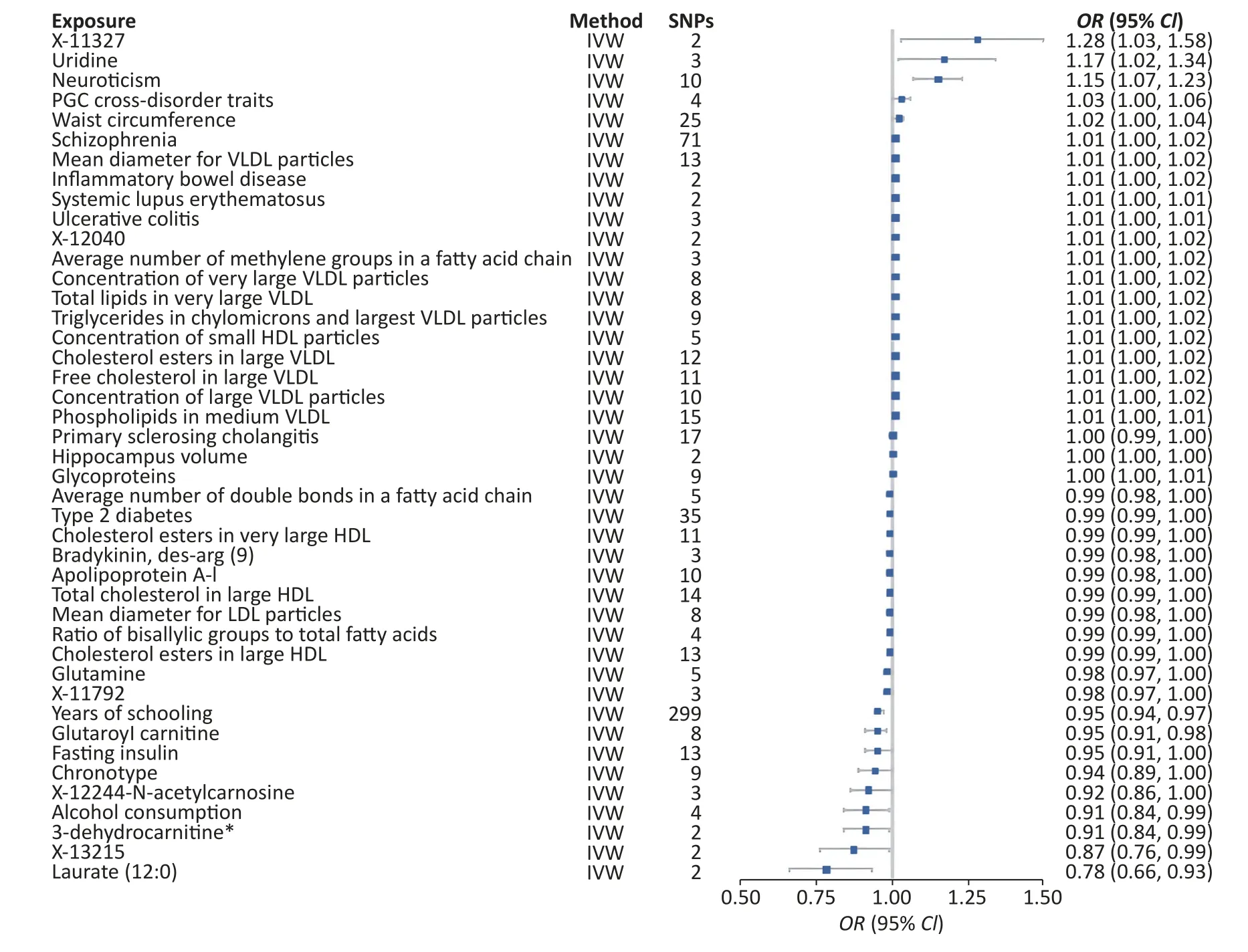
Figure 4.MR analysis of factors associated significantly with risk of depression.There are 43 different types of risk factors exposures on depression per unit of exposure.IVW: Inverse variance weighted; SNP:single nucleotide polymorphisms; MR, Mendelian randomization; OR: odds ratio; SD, standard deviation.
Genetically variant SNPs of the therapeutic target genes were selected to identify potential therapeutic drugs for depression using ADHD, SCZ,Inflammatory bowel disease (IBD) (IVW,OR= 0.98,95%CI: 0.97-1.00,P= 0.04), Alzheimer’s disease(AD) (IVW,OR= 0.96, 95%CI: 0.92-1.00,P= 0.03) as instrumental exposure variables.Major depressive disorder was used as the outcome variable for 2SMR analysis.The DrugBank database search retrieved 16 drugs for ADHD, corresponding to 135 drug targets;35 drugs for SCZ, corresponding to 452 drug targets;12 drugs for IBD, corresponding to 24 drug targets;and 8 drugs for AD, corresponding to 95 drug targets(Supplementary Table S5).Crohn’s disease was among IBD diseases, but PGC cross-disorder traits could not be calculated as independent diseases;thus, only ADHD, SCZ, IBD, and AD were evaluated.
The top nine targets selected through MR analysis included sodium-dependent noradrenaline transporter (SLC6A4), glutathione S-transferase P(GSTP1), glutamate receptor ionotropic NMDA 2C(GRIN2C), neuronal acetylcholine receptor subunit alpha-3 (CHRNA3), glutamate receptor ionotropic NMDA 2A (GRIN2A), gamma-aminobutyric acid receptor subunit gamma-2 (GABRG2), sodium channel protein type 10 subunit alpha (SCN10A), 5-hydroxytryptamine receptor 3A (HTR3A), and interleukin-1 beta (IL1B).The findings showed thatSLC6A4(IVW,OR= 1.03, 95%CI: 1.00-1.06,P=0.05),GRIN2A(IVW,OR= 1.04, 95%CI: 1.01-1.06,P< 0.01),GRIN2C(IVW,OR= 1.02, 95%CI: 1.01-1.04,P< 0.01),SCN10A(IVW,OR= 1.08, 95%CI:1.01–1.16,P= 0.03), andIL1B(IVW,OR= 1.03, 95%CI: 1.01-1.06,P= 0.01) are positively correlated with the risk of MDD.Thus, high expression ofSLC6A4,GRIN2A,GRIN2C,CHRNA3,SCN10A, andIL1Bmay increase the risk of MDD.Additionally,CHRNA3(IVW,OR= 0.95, 95%CI: 0.92-0.98,P< 0.01),GSTP1(IVW,OR= 0.84, 95%CI: 0.73-0.98,P= 0.02),HTR3A(IVW,OR= 0.96, 95%CI: 0.92-1.00,P= 0.04),GRIN2A(IVW,OR= 0.84, 95%CI: 0.73-0.92,P= 0.02)with high expression may reduce the risk of MDD(Supplementary Table S6, available in www.besjournal.com).
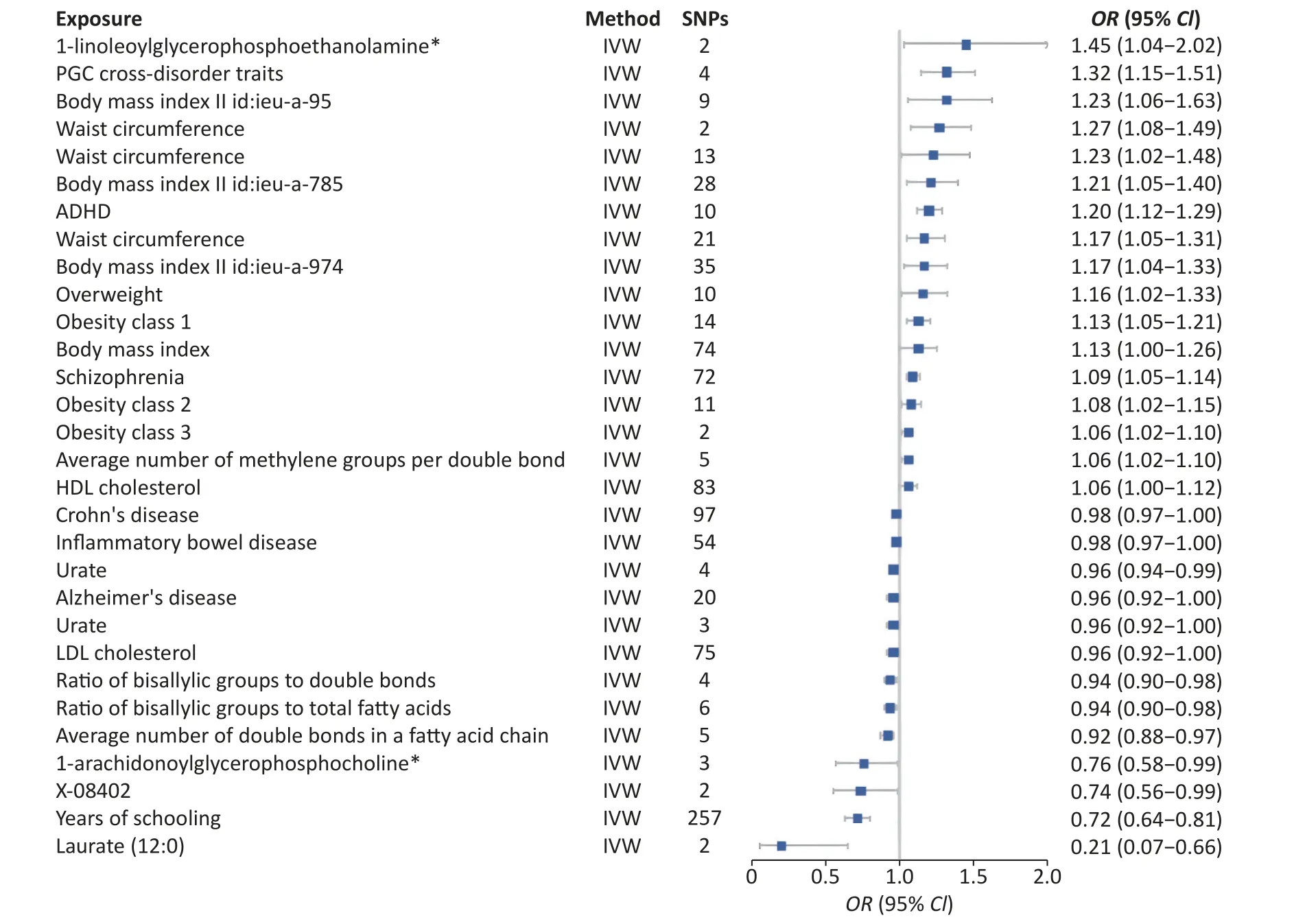
Figure 5.MR analysis of factors associated significantly with risk of MDD.There are 30 different types of risk factors exposures on MDD per unit of exposure.IVW: Inverse variance weighted; SNP: single nucleotide polymorphisms; MDD, major depressive disorder; MR, Mendelian randomization; OR: odds ratio.
DISCUSSION
In this study, a 2SMR assessment identified several risk factors for depression.The disease risk factors showed that SCZ, AD, inflammatory bowel disease and PGC cross-disorder traits were significantly associated with the risk of depression and MDD.Further analysis indicated that high expression ofSLC6A4,SCN10A,GRIN2A,GRIN2C, andIL1Bare correlated with the increased risk of MDD.In contrast, up-regulatingCHRNA3,HTR3A,GSTP1,andGABRG2reduces the risk of MDD.
Sodium-dependent noradrenaline transporter is a serotonin transporter that removes serotonin from the synapse.A decline inSLC6A4expression upregulates the expression of pentraxin proteins[26].Moreover, methylation of theSLC6A4gene drives the action of selective serotonin reuptake inhibitors(SSRIs).The SSRIs increase methylation of CpG-3,CpG-11, and CpG-12[27].Decreased methylation of CpG-3 and CpG-5 exacerbates the symptoms of depression; thus, increasing CpG-3 methylation alleviates the clinical symptoms of depression[28,29].These findings indicate thatSLC6A4is a potential risk factor for depression.
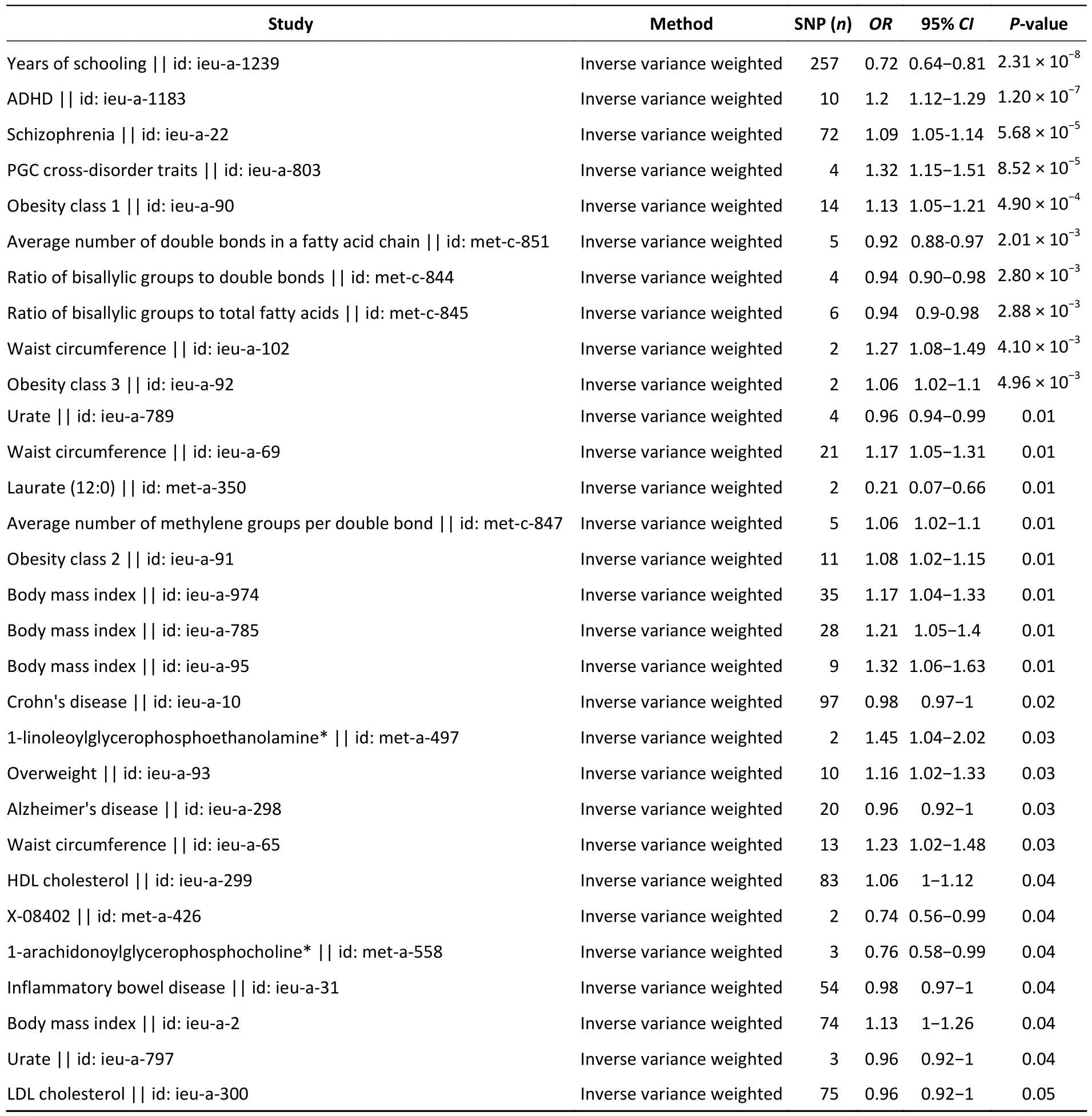
Table 2.2SMR estimates of the significant results in MDD
Further,GRIN2A, a receptor for N-methyl-daspartate (NR2A), is implicated in several synaptic plasticity-related regulatory processes associated with MDD pathogenesis[30,31].Overexpressing GRIN2A may enhance MDD susceptibility by upregulating NMDA receptor-dependent glutamatergic neo-signatures.Functional inactivation of NR2A in knock-out mice models caused reduced anxiety and depression-related behaviors[31,32].Ketamine is an NMDA receptor antagonist used as a rapid antidepressant agent for depressed patients.Previous findings indicate that ketamine acts by up-regulating synaptogenesis and synaptic plasticity in the hippocampus (HIP) and prefrontal cortex (PFC)[33,34].These findings indicate that regulatingGRIN2Aexpression treats depression indirectly.Additionally,GRIN2Calleviates MDD symptoms by up-regulating NR2A expression[35].
However, some genes implicated in Gamma amino butyric acid (GABA) metabolism affect suicidal behavior in patients with depression.For instance,expressing Genotype AA of the rs424740 SNP in GABRG2 is correlated with suicidal behavior[36,37].Down-regulating the RNA isoform GABRG2-003 (the largest GABEG2 protein-coding RNA isoform)promotes suicidal behavior and is associated with GABAergic dysfunction[38,39].
This study identified several factors as potential risks or protective factors for MDD.For example,SLC6A4,GRIN2A, andGRIN2Cexpression are correlated with an increased risk of MDD, whereasGABRG2expression is correlated with decreased risk of MDD.Further studies should explore the potential of regulating the expression of these genes to prevent or treat MDD.In addition, further studies should evaluate the potential ofADRB1,CHRNA3,HTR3A,GSTP1,SCN10A, andIL1Bas therapeutic targets for treating MDD and their mechanisms of action.
Depression is a class of diseases that significantly impact human health, yet it lacks psychotropic targeted drugs.This study identified significant associations between nine targets (SLC6A4,SCN10A,GRIN2A,GRIN2C,IL1B,CHRNA3,HTR3A,GSTP1, andGABRG2) and depression.This discovery is very important for developing precise targeted drugs for depression.However, these targets still need further validation using experimental methods.
Limitations
Several factors limited this study.First, only three categories, including metabolites, disease,and risk factors, were selected as exposure factors for MR analysis, ignoring other factors that may affect depression.Second, the GWAS data on depression was utilized, and not data from individuals with or without clinical symptoms of depression.Third, the assessment of depression was based on an extensive investigation methodology, which may not reproduce a clinical diagnostic approach.
CONCLUSION
This study explored factors causally associated with the risk of depression through 2SMR analysis owing to the increased prevalence of depression globally.The findings showed that several risk factors are associated with increased/decreased risk of depression and MDD.A significant relationship was observed between various diseases and depression.The 2SMR analysis used protein targets retrieved from DrugBank as exposure factors that identified the risk or protective targets.Integrating various therapeutic targets can increase the number of treatment modalities for depression.Several drug targets,includingSLC6A4,GRIN2A,GRIN2C,SCN10A, andIL1Bgenes (associated with increased risk of depression) andADRB1,CHRNA3,HTR3A,GSTP1,andGABRG2genes (associated with decreased risk of depression) were identified.These findings provide a pharmacological basis for conducting further studies to explore effective treatment strategies for depression.
AUTHOR CONTRIBUTORS
WANG Han Lin: searched the literature, designed the study, collected the data, checked and analyzed data, and drafted the article.XUE Yan Feng: analysis of results and discussion.CUI Bao Qiu: collected the data.LIU Hong and SHEN Xin Xin: designed the study, and revised the article.
CONFLICTS OF INTEREST
The authors declare no conflicts of interest.
Received: February 5, 2023;
Accepted: May 4, 2023
 Biomedical and Environmental Sciences2024年1期
Biomedical and Environmental Sciences2024年1期
- Biomedical and Environmental Sciences的其它文章
- Correlation between Combined Urinary Metal Exposure and Grip Strength under Three Statistical Models: A Cross sectional Study in Rural Guangxi*
- Effects of Bisphenol A and lts Substitute, Bisphenol F, on the Gut Microbiota in Mice*
- The Uptake and Distribution Evidence of Nano- and Microplastics in vivo after a Single High Dose of Oral Exposure*
- The Effect and Mechanism of Fructus lycii on lmprovement of Exercise Fatigue Using a Network Pharmacological Approach with in vitro Experimental Verification*
- Quercetin Alleviates Lipopolysaccharide-lnduced Cardiac lnflammation via lnhibiting Autophagy and Programmed Cell Death*
- Exosome-Transmitted miR-224-5p Promotes Colorectal Cancer Cell Proliferation via Targeting ULK2 in p53-Dependent Manner*
